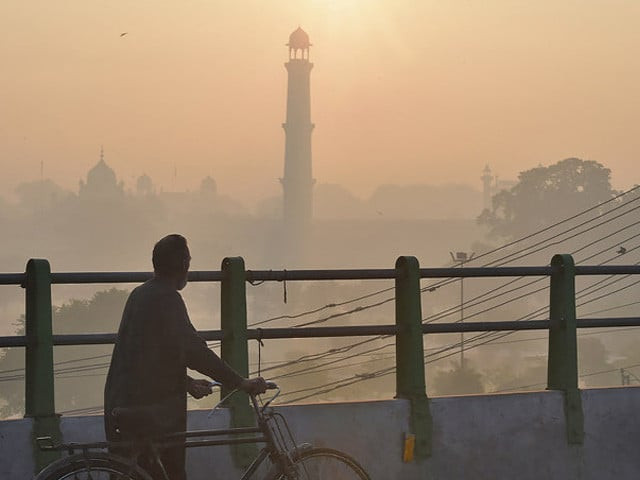When winter comes, it engulfs Lahore entirely and most parts of the Punjab province with fog and smog, leaving most of Lahoris wearing masks, enduring terrible cough and the air quality index dropping down to the lowest. Over the past decade or so, we have associated the winter season with a new kind of bitter memory and is no more as eagerly celebrated.
Growing up in the city of Lahore, we do get to see almost every colour of mother nature. Lahore – the heart of Pakistan, the capital of the Punjab province, the city of gardens – has its own flare, colours and fragrances. It is this vibrancy of Lahore that makes it stand out among the other cities of Pakistan. It has been the centre of cultural activities even before the Mughals. There are always celebrations going on in every season. The arrival of spring announces a string of cultural and historical events that go on for months. Summer is welcomed with multicolour flowers and different festivities.
Punjab is the most populous province in Pakistan, with an estimated population of 110 million people. Five cities in Punjab were listed among the 50 most polluted cities in the world in 2020. The current situation in Lahore is most alarming, with its fine particulate count repeatedly rising well above 40 times the World Health Organization’s air quality guideline values. The Global Alliance on Health and Pollution estimated in 2019 that 128,000 Pakistanis die annually due to air pollution-related illnesses.
Reasons are numerous why air quality has been steadily declining in cities like Lahore. The problem includes vehicular emissions, industrial pollution, fossil fuel-fired power plants, burning waste materials, and burning coal by thousands of brick kilns scattered across the province, are all part of the problem. A 2020 source appropriation study by the Food and Agriculture Organisation singles out power producers and the transport sector in particular as the culprits. Over the past decade or so, Lahore has lost a significant proportion of its forestation due to an aggressive plan to build highways, underpasses and overpasses. Car sales in the city are booming, and many of the vehicles plying the roads spew toxic emissions due to a lack of vehicular inspections and widespread adulteration of fuel. Even the unadulterated form of fuel available in Lahore is of low quality. Alas!
This problem has not only been wreaking havoc in Pakistan, but the same has happened in our neighbouring Indian Punjab as well, where life gets paralysed during winters due to deadly smog. In both countries, during the past few years, governments have taken some concrete steps to stop the farmers from stubble burning. It has helped a great deal in reducing smoke in the air.
Another main reason for smog in Punjab is brick kilns. According to the latest survey, there are more than 8,000 brick kilns in Punjab alone. During the previous government, it was claimed that almost all of these kilns were converted to a new eco-friendly technology called “zigzag”. The new technology emits 60 per cent fewer carbon emissions and helps 30 per cent more savings for kiln owners. It merits mentioning here that Natural Draught Zigzag firing kiln is a continuous, cross-draught, moving fire kiln in which the air flows in a zigzag path due to the draught provided by a chimney. The International Centre for Integrated Mountain Development (ICIMD) and National Energy Efficiency and Conservation Authority provided technical assistance to brick kiln owners, which was supported by the Punjab Environmental Protection Department and Provincial Disaster Management Authority (PDMA) Punjab.
In the absence of comprehensive and concerted efforts to combat air pollution, Lahore, ironically known as the city of gardens, has been tragically choking on toxic air. However, all efforts should be appreciated that take the people of Punjab, especially Lahore, out of the misery of smog. It is being suggested that eco-friendly steps that have been taken in the recent past will help the environment improve and curb the amount of smog this season. Enforcement of the measures to stop the farmers from stubble burning has been implemented, and strict actions have been carried out against the perpetrators. These enforcements definitely helped the cause, as we, the residents of Lahore, always pray for a safe, smog-free, allergy-free winter season that can be celebrated. We want to enjoy the declining temperatures, we want to enjoy different delicious foods, and we would love to have a walk down the chilly streets of the city of gardens.
It is our duty as citizens to take care of the environment around our city. We should carefully dispose of the garbage, and cooperate with different local environmental authorities. We have to curb transport and its pollution. Although there are fewer spews of smog as of now, yet we should take all the precautionary measures.
Let’s hope for the restoration of the beauty of this season for our city of gardens and our Punjab province. Let’s hope that we may enjoy a cleaner and much safer winter this year.


HarrisShahProfilePic011669202728-0/(Blogs)HarrisShahProfilePic011669202728-0.webp)
COMMENTS
Comments are moderated and generally will be posted if they are on-topic and not abusive.
For more information, please see our Comments FAQ